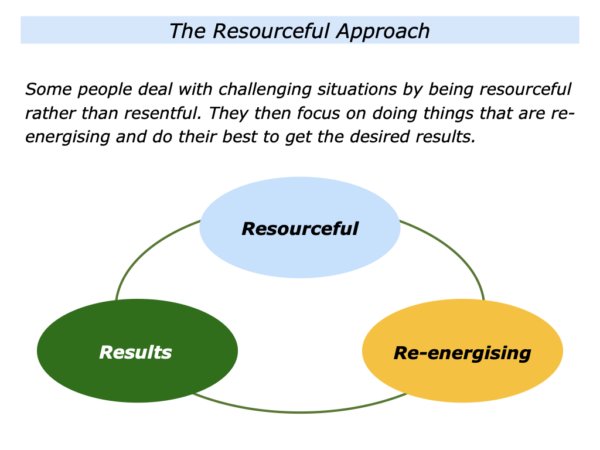
There are many ways to deal with setbacks, disappointments and challenging situations. Some people choose to be resourceful rather than resentful.
Such people use their creativity to explore the possible ways forward. They then do things that are re-energising and do their best to get the desired results.
People who take these steps can feel revitalised and get a sense of renewal. This can increase their resilience and ability to shape a positive future. Let’s explore these themes.
Resourceful
Imagine that you have had a setback. You may want to buy time to rest, regain your energy and refocus. You may then aim to find positive ways to shape your future. How to take this step?
One approach is to learn from your own positive history. Another approach is to learn from other people’s experiences. Let’s explore these themes.
The Learning From Your
Positive History Approach
Looking back, can you recall a situation when you chose to be resourceful rather than resentful? You may have done this after experiencing a loss, a disappointment or a feeling a sense of injustice.
What was your first reaction to the event? You may have felt angry, hurt or rejected. How did you to take time to heal, reflect and begin to resurface?
How did you then focus on the future? How did you clarify what you could control in the situation? How did you clarify the real results to achieve – the pictures of success?
How did you explore the possible ways forward? How did you decide on your chosen route? How did you translate this into a specific plan? How did you move into action?
How did you get an early success? How did you encourage yourself on the journey? How did you do your best to achieve the desired results? What happened as a result of taking these steps?
Looking ahead, how can you follow some of these principles to manage setbacks in the future? What other skills may you need to add? How can you be resourceful and aim to achieve your picture of success?
The Learning From Other
People’s Experiences Approach
Another approach is to learn from other people’s experiences. Al Siebert’s books The Survivor Personality and The Resiliency Advantage laid the foundations for much of today’s work on being resourceful and resilient.
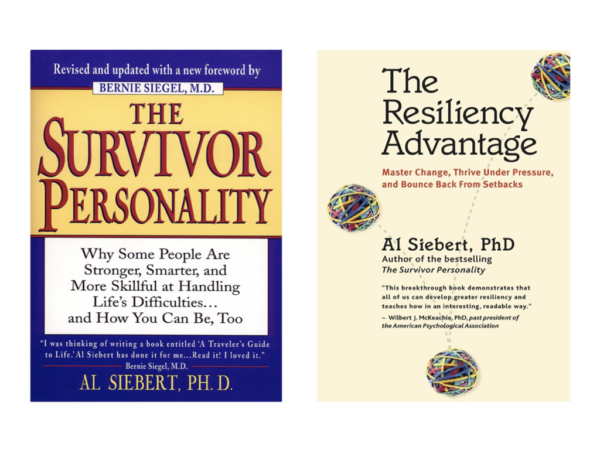
Al spent over 40 years studying life’s survivors – those who grew when overcoming tough challenges. He initially focused on people that met four criteria:
They had survived a major crisis;
They had surmounted the crisis through personal effort;
They had emerged from the experience with previously unknown strengths and abilities;
They had, in retrospect, found value in the experience.
Al describes people who had faced various challenging situations. These included sexual assaults, life-threatening illnesses, being prisoners of war, addictions, physical attacks and crippling accidents.
How do people cope with such adversity? Some don’t, says Al. They feel victimised, become helpless or lash out at others. Some people do deal with adversity. Al described some of the steps that such people take.
They stay calm, clarify the situation and chart their strategy. Committing to their course of action, they concentrate fully until they reach their chosen goal. Al wrote:
They thrive by gaining strength from adversity and often convert misfortune into a gift.
Are life’s best survivors different from other people? No. They survive, cope, and thrive better because they are better at using the inborn abilities possessed by all humans.
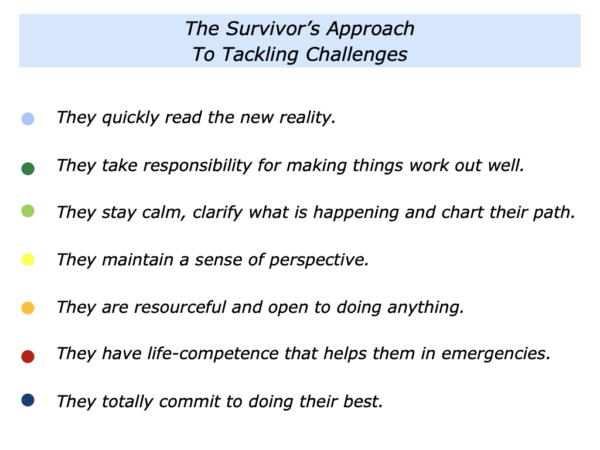
They quickly read the new reality
Survivors have experience of overcoming difficulties in life. They read situations quickly and start considering the consequences. Other people ignore what is happening or bury their heads in the sand. Survivors click into awareness mode and take snapshots of what is actually happening.
They stay calm
Why? They realise it is vital to establish clarity. They must clarify what is happening and then make decisions about the way forward. The best way to do this is to get in the helicopter and take an overall view.
They maintain a
sense of perspective
People who are diagnosed with a serious illness, for example, may reframe it as a project. Looking at it from this perspective, they are able to remove themselves and plan the path ahead.
They clarify their assets. They focus on their relationships, knowledge, talents and the healthy parts of their body. Mobilising these assets, they then tackle the challenge.
They are resourceful and
open to doing anything
Al found that survivors chose their strategies from a wide repertoire of options. One contributing factor is that they have a quality common to many peak performers. Such people embrace what appear to be seeming paradoxes.
They are able to see the big picture and the small details, to be focused and flexible, to be serious and playful. This means they are able to see a wider number of options than people who have been trained to behave in one way.
They have life-competence
that helps them in emergencies
Survivors are life-long learners. Such people tend to be savvy rather than having lived a sheltered life. This enables them to read situations, call on their experience and make decisions.
Moving into action, they observe what is happening – what is working and what isn’t – and are prepared to change direction. This is a great advantage when tackling problems or emergencies.
They totally commit
to doing their best
Survivors make their decision and throw themselves into pursuing their chosen strategy. They employ every ounce of energy to reach the goal. Al described this in the following way.
The survivor way of orientating to a crisis is to feel fully and totally responsible for making things work out well.
Such people often grow from the experience. They continue to expand their resilience and repertoire, but they also develop a sense of perspective about life. Al described them in the following way.
Resilient adults are happy rather than hostile. They forgive instead of holding grudges and are more playful than serious.
They get better and better every decade because they have a child-like curiosity. They ask questions, explore, want to know how things work, and learn valuable lessons in the school of life.
Imagine that you have been resourceful when facing a challenging situation. Sometimes it can then be useful to focus on the following theme.
Re-energising
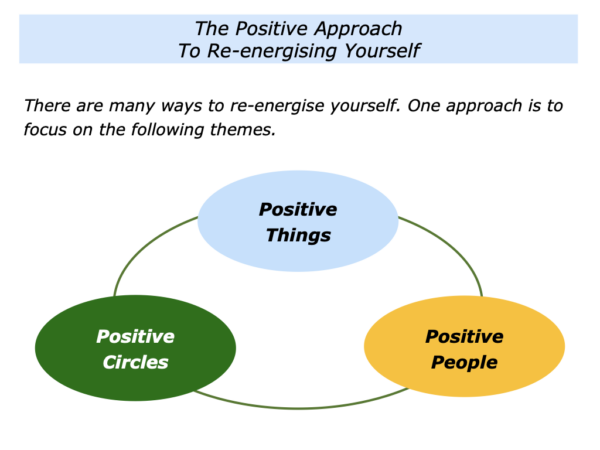
Different people re-energise themselves in different ways. Some aim to rest, reflect and recentre. They then refocus and rehearse what they are going to do next.
Some take another approach. They aim: a) to build on the positive things in their life; b) to spend time with positive people; c) to put themselves into positive circles rather than negative circles. Let’s explore these themes.
Positive Things
What are the positive things in your life? Different people describe different things when exploring this theme. Here are some they mention when describing these things.
The positive things in my life are:
Our children – who give us joy … My partner – who gives me encouragement … Our pets – who give us pleasure … Our house – which is warm, cosy and reassuring … Our food – which is nourishing … Our garden – which is wonderful to be in and feeds our souls.
My health – which is good for my age … My upbringing – in which my parents gave me love, support and encouragement … My education – which was mainly self-study and involved exploring, reading and meeting good models.
My strengths – which have provided the opportunity to do satisfying work and earn a good salary … My drive – which means I want to continue developing … My professional network – which consists of many encouraging people.
My opportunities in the future – such as the many chances to encourage people … The opportunities to pass on knowledge – such as through writing and mentoring … The chance to encourage grandchildren – though it will be up to our kids regarding how they want to shape their future lives.
Imagine that you have described the positive things in your life. If appropriate, you may want to continue to appreciate and build on these things. Different people choose different ways to take this approach. One person expressed this in the following way.
“The exercise reminded about the important things in my life. My first reaction was to safeguard and support these things. This led to spending more quality time with my family.
“This coincided with my boss at work taking time out to care for his partner who had a serious illness. He repeated the well-known story about us each of us juggling rubber and glass balls in our lives.
“He said that the rubber balls bounce back if we drop them. But it is important not to drop the glass balls – such as our family relationships. I took this message to heart.
“Moving on to my professional life, I returned to doing what I did best. It meant leaving the C-Suite and working directly with clients, which was immensely satisfying. I continue to enjoy work to this day.”
Different people have different triggers for taking such steps. Some do it after a Eureka moment when they realise what is important. Some did it after the Covid pandemic. Some do it to simply feel positive and make the most of life.
Imagine that you want take some of these steps. How can you build on the positive things in your life? What may be the benefits of taking these steps – both for yourself and for other people?
If you wish, try tackling the exercise on this theme. This invites you to complete the following sentences.
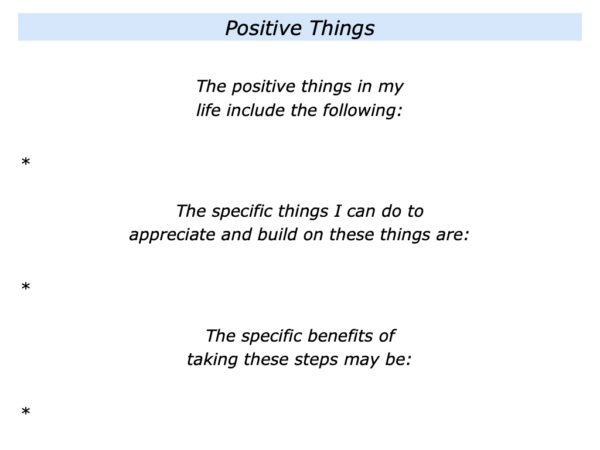
Positive People
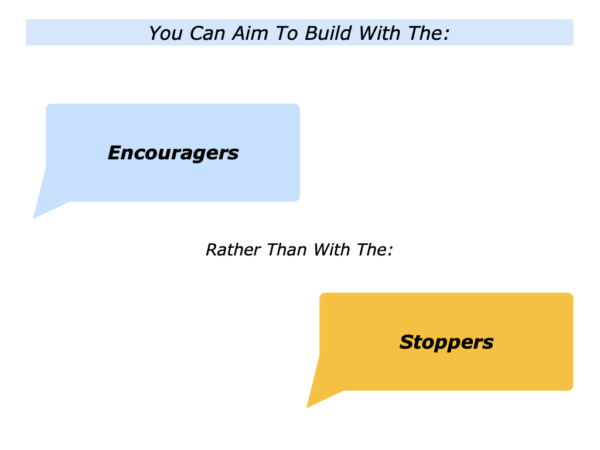
Who are the positive people in your life? How can you spend more time with these people? How can you also encourage them? There are many ways to identify such people.
One approach is to do the exercise called Encouragers and Stoppers. This is an exercise that I often used on strengths workshops. The aim was to help people to identify how they could encourage themselves and other people in the future. Here are the instructions for the exercise.
Encouragers
Who have been the people who have encouraged you in the past? They may have been parents, teachers, friends or other people. Write the names of these people and the specific things they did to encourage you.
Who are the people who encourage you now? These may be people in your family, work place or elsewhere. Write the names of these people and what they do to encourage you.
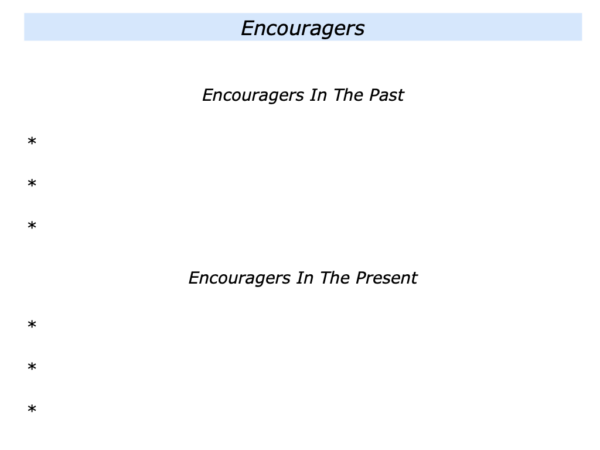
Stoppers
Who have been the people with whom you have felt stopped? Some of these people may have had the best of intentions but their style may have been difficult to manage. Write the names of these people.
Who are the people – or what are the situations – in the present where you feel stopped? You have a responsibility to do your best, of course, but you may feel disqualified or not valued in certain situations. This can be challenging.
Two other points are worth mentioning. First, some people will both encourage you and stop you. If so, describe how they encourage you and also how they may feel stopped.
Second, some people stop themselves. They may do this by following negative scripts or by not doing their best. If appropriate, describe how you may stop yourself in certain situations. Here is the exercise on stoppers.
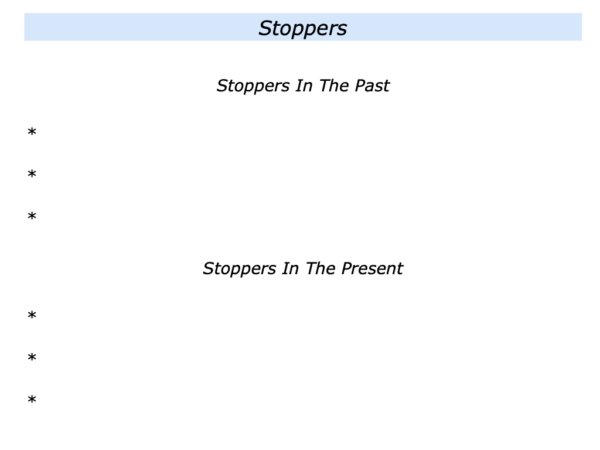
Encouragers And
Stoppers In The Future
Imagine that you have made a list of encouragers and stoppers. Looking ahead, you may want to consider the following themes.
Encouragers
Let’s start with the people who are supportive or stimulating. How can you build with such people? One approach is to be an encourager yourself and aim:
To spend more time the encouragers … To encourage the encouragers and other people … To encourage yourself.
Stoppers
Let’s move onto the situations where you may feel stopped. When appropriate, it can be good to stop putting yourself into such situations. If this is not possible, you may aim:
To rehearse what you are going to do when encountering such people or situations;
To recognise the specific things they do that trigger your emotions and also learn how to manage such triggers;
To, but only when you feel it is appropriate, suggest positive ways the person may want to consider behaving in the future – plus describe the benefits for both themselves and other people.
Here is the final exercise on this theme. This invites you to focus on how you can build with encouragers and manage situations where you may feel stopped.
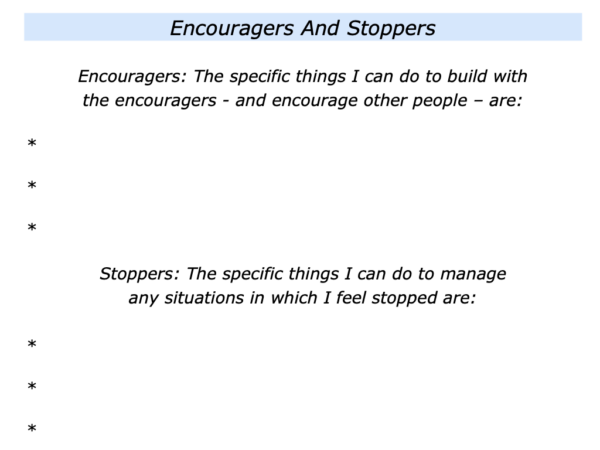
Positive Circles
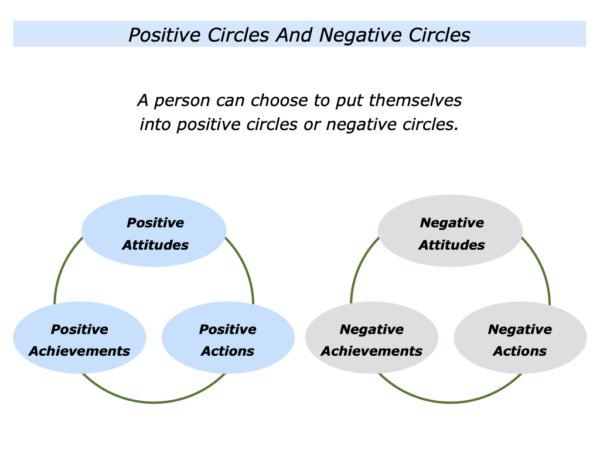
There are many ways to live life. One view is that a person can choose to put themselves into positive circles or negative circles. Let’s explore this view.
Positive Circles
Looking back, can you think of a time when you put yourself into a positive circle? You may have chosen to have a positive attitude, translate this into positive actions and, as a result, achieve positive things.
You may have been changing your lifestyle, recovering from a setback, tackling a challenge or doing another activity. This may have led to you encouraging both yourself and other people.
Different people follow this approach in different ways. Here are some of the ways that people may describe how they follow positive circles rather than negative circles in their life and work.
Positive Circles – I Can Choose:
To take responsibility for shaping my future … To follow a structure in my daily life … To do something each day towards achieving my life goals … To eat nutritious food … To walk several times a day … To do things that gave me positive energy … To spend time with positive people.
To get an early success each day … To do more of the work that gives me satisfaction … To set goals and get a sense of success … To be kind … To build on who I am rather than worry about who I am not … To reflect on the positive things that have happened that day.
Somebody who puts themselves into positive circles may find these can lead to a tipping point. They may reach a stage where the habits they follow can lead to a transformational effect. They may get into the habit of living a positive life.
Negative Circles
Some people put themselves into negative circles. They may have a negative attitude, translate this into negative actions and, as a result, achieve negative things. They may hurt themselves or other people.
Different people take this approach in different ways. Here are some of the ways that people may describe how they follow positive circles in their life and work.
Negative Circles – I Can Choose:
To not take responsibility … To see myself as a victim … To say the world is to blame … To let myself drift rather than follow a structure in my life … To fail to exercise … To eat poor food … To stop doing the things that I enjoy.
To compare myself to other people … To feel stuck in a job and not plan how to do something better … To focus on what is wrong in the world … To not manager triggers that can lead to me going into a downwards spiral … To feel there is no hope.
Somebody who puts themselves into negative circles may reach another kind of tipping point. They can get to a point where they fall into a constant state of negativity, cynicism or depression.
Positive Circles
In The Future
Let’s return to your own life. Imagine that you want to put yourself into positive circles in the future. How can you make this happen?
You may want to maintain a sense of gratitude and encourage other people. You may want to create and follow a structure in your life. You may want to do things that give you positive energy.
You want to build on your strengths and do satisfying work. You may want to be the best you can be rather than compare yourself to others. You may something each day towards achieving your life goals.
How can you react if you find yourself getting into a negative circle? One approach is: a) to recognise what is happening; b) to do something to put yourself in a positive circle; c) to get a quick success. It is then to build on this momentum and get positive results.
You will have your own approach to putting yourself into positive circles rather than negative circles. Taking these steps can sometimes benefit both yourself and other people.
If you wish, try tackling the exercise on this theme. This invites you to complete the following sentences.
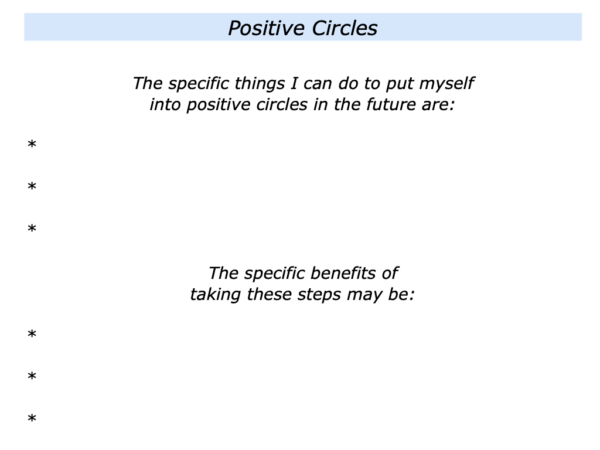
Imagine that you are aiming to manage a challenging situation. So far we have looked at how you can be resourceful and re-energise yourself. Let’s now move on to the next theme.
Results
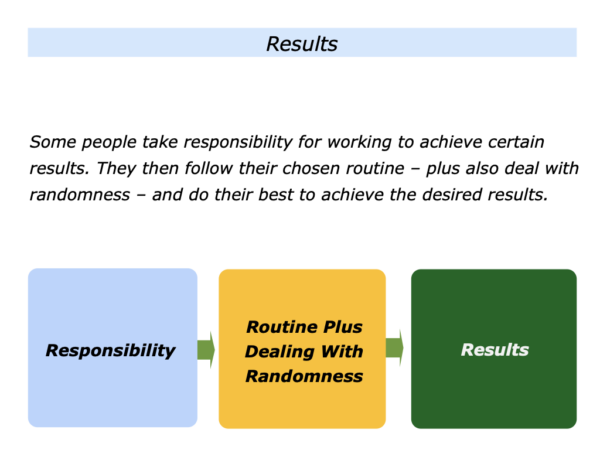
Different people choose different ways to recover from setbacks or manage challenging situations. Some people focus on the following themes.
Responsibility
Such people take responsibility for shaping their future and aim to achieve certain goals. They may aim to find a new job, stay sober, encourage other people or achieve another goal.
Routine
Such people then aim to follow a certain routine that will increase their chances of achieving the goals. They also plan how to anticipate and deal with random events that could throw them off-track.
Results
Such people get some early successes, maintain good habits and encourage both themselves and other people. They make the journey as rewarding as possible and do their best to achieve the desired results.
Different people follow this approach in different ways. The following pages look at three ways that people may follow it when tackling certain challenges.
These are The One Day At A Time Approach, The Win The Next Moment Approach and The Guidelines For Thriving When Looking For A Job Approach. Let’s explore these themes.
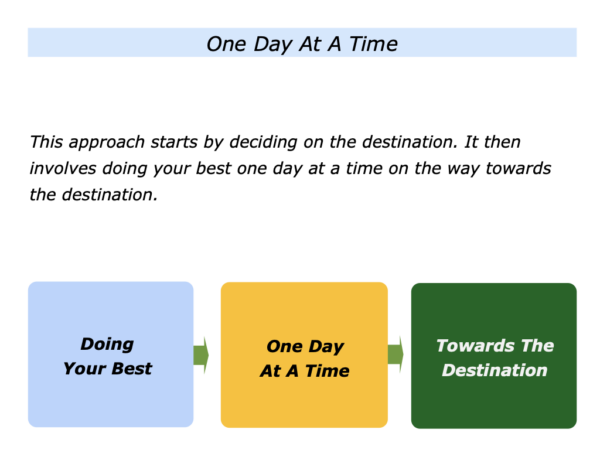
The one day at time approach is associated with recovering from addictions but it is used in many other situations. It may be followed by individuals who pursue a certain path or work towards a specific goal.
The approach starts by a person deciding on their destination. This can involve them focusing on:
A state of being – such as being healthy, being kind or being at peace
A specific goal – such as a personal aim, a positive legacy or a picture of success
The person may then make a specific action plan. They may focus on how they can do their best each day, each week and each time period on the way towards their chosen destination.
This approach is followed by people in many fields. They may aim to pursue a spiritual faith, follow certain habits or achieve a goal. Some create mantras they aim to follow on the way towards achieving their aims. This can involve taking the following steps.
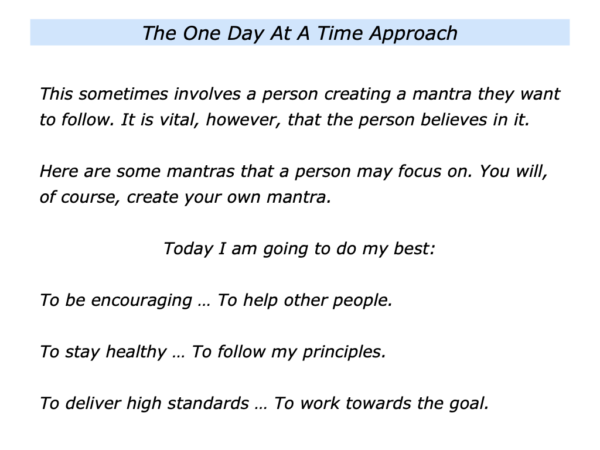
Looking back, can you think of a time when you followed elements of this approach? This could have been in your personal or professional life.
You may have done this when recovering from an illness, helping a person to get through a crisis or when tackling a challenge. You may have applied it when working towards a long-term goal.
How did you make action plans for each day? How did you encourage yourself on the journey? How did you get short-term successes? How did you continue to work towards the long-term picture of success?
During my early career I worked with recovering addicts who focused on staying healthy one day at a time. Since then I have worked with many caring people, creative artists and peak performers who have taken a similar approach.
Such people often focus on one principle where they want to do their best. They may aim:
To be encouraging one day at a time … To help one patient at a time … To write one page at a time.
They may find that following their mantra in one area has a knock on effect. They may begin to improve in other areas of their life. They may also recognise the philosophy that:
The journey is the destination and the destination is the journey.
There are many applications of the one day at a time approach. Let’s look at a similar approach that is followed by people in sports but it can also be applied in other fields.
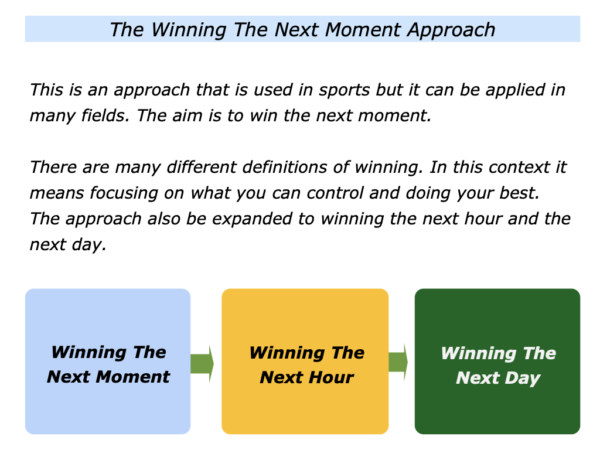
This is an approach that is used in sport. The aim is to win the next moment. It is an approach that can also be expanded to other areas of life.
There are different views on winning. In this context, winning means focusing on what you can control and doing your best. Some people expand this to winning the next moment, the next hour and the next day.
Paul O’Connell, the former Irish Rugby Union player, described this approach a talk he gave to a Pendulum Summit in 2018. Here is a summary of what he said about giving your best throughout a game.
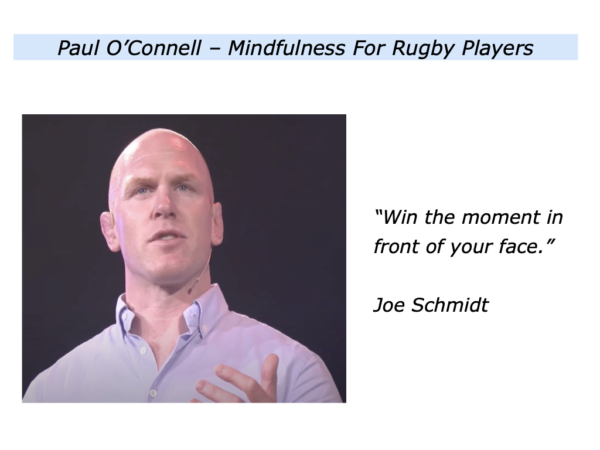
Paul called the approach ‘mindfulness for dumb rugby players’. The team’s coach Joe Schmidt kept giving his players the following message. Forget the mistake you have made, forget the try you have scored. Be fully present and win the next moment in front of your face.
As mentioned earlier, some people apply this to doing their best in their lives. They may do this when aiming:
To stay healthy one day at a time when recovering from an addiction … To focus on one shot or one game at a time when playing a sport … To do their best to achieve their desired results.
Let’s look at another application of this approach. This involves returning to some of the work done by Al Siebert.
The Guidelines For Thriving When
Looking For A Job Approach
Al Siebert helped many people to thrive in challenging situations. These included helping people who had lost their jobs. The following ideas from his 1993 book The Survivor Personality are still relevant today.
Losing your job through no fault of your own can wipe you out emotionally. How do you find the energy to search for work? How do you deal with your anger?
How can you be pleasant, relaxed, and self-confident in an interview when you don’t feel that way? Here are some guidelines for handling the emotional challenge of dealing with job loss and searching for new employment.
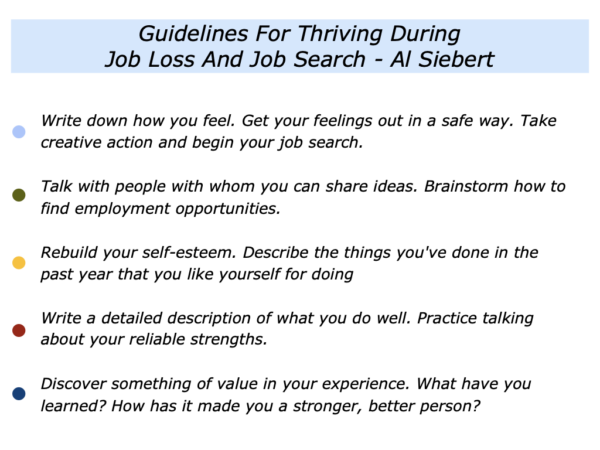
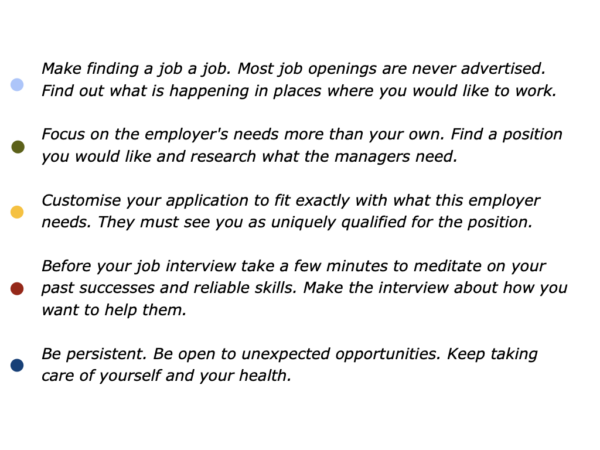
Let’s return to the original theme. People can choose to be resourceful rather than resentful when managing challenging situations. They can then re-energise themselves and do their best to achieve the desired results.
Looking ahead, can you think of a situation where you may want to follow elements of this approach? How can you do this in your own way? What may happen as a result of taking these steps?
If you wish, try tackling the exercise on this theme. This invites you to complete the following sentences.
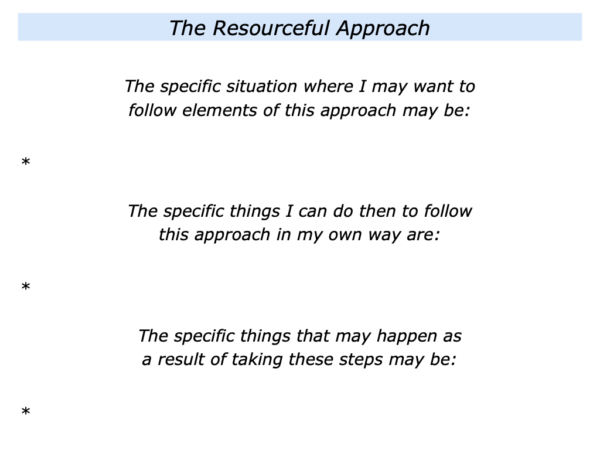


Leave a Reply